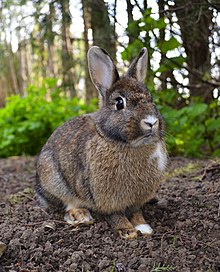
Back ጥንቸል Amharic Kudiwis AMI Coning ANG أرنب Arabic শহাপহু Assamese Wank'u Aymara Adadovşanı Azerbaijani Kelinci BAN Triošis BAT-SMG Трусы (жывёлы) Byelorussian
| Rabbit | |
|---|---|

| |
| European rabbit (Oryctolagus cuniculus) | |
| Scientific classification | |
| Domain: | Eukaryota |
| Kingdom: | Animalia |
| Phylum: | Chordata |
| Class: | Mammalia |
| Order: | Lagomorpha |
| Family: | Leporidae |
| Included genera | |
| Cladistically included but traditionally excluded taxa | |
Rabbits are small mammals in the family Leporidae (which also includes the hares), which is in the order Lagomorpha (which also includes pikas). The European rabbit, Oryctolagus cuniculus is the ancestor of the world's hundreds of breeds[1] of domestic rabbit. Sylvilagus includes 13 wild rabbit species, among them the seven types of cottontail. The European rabbit, which has been introduced on every continent except Antarctica, is familiar throughout the world as a wild prey animal, a domesticated form of livestock and a pet. With its widespread effect on ecologies and cultures, in many areas of the world, the rabbit is a part of daily life – as food, clothing, a companion, and a source of artistic inspiration.
Rabbits are a paraphyletic grouping, and do not constitute a clade, as hares are nested within the Leporidae clade and are not included in rabbits.
Although once considered rodents, lagomorphs diverged earlier and have a number of traits rodents lack, including two extra incisors.
- ^ "Data export". DAD-IS (Domestic Animal Diversity Information System). FAO (Food and Agriculture Organization of the United Nations). 21 November 2017. Retrieved 30 March 2018.
© MMXXIII Rich X Search. We shall prevail. All rights reserved. Rich X Search